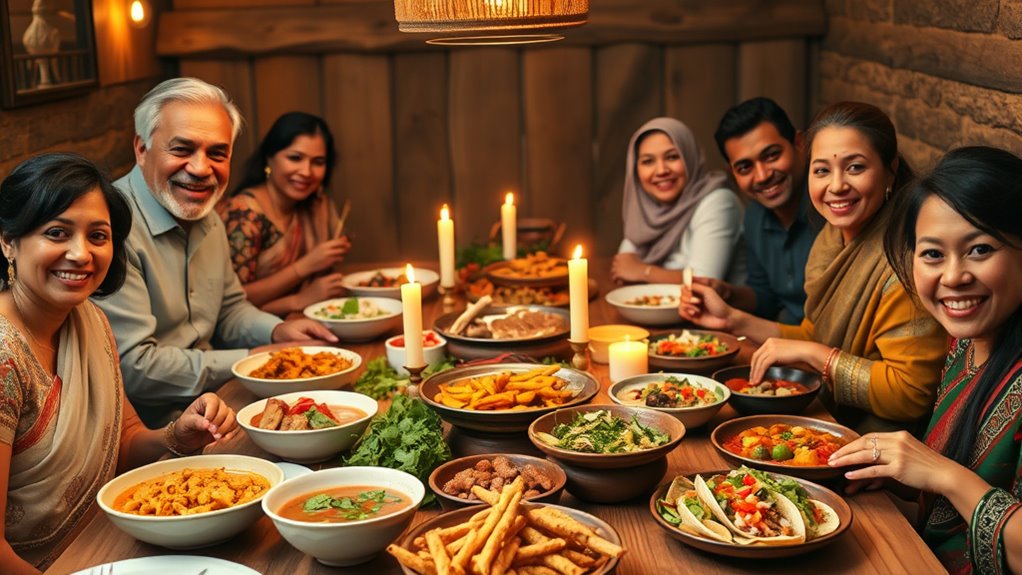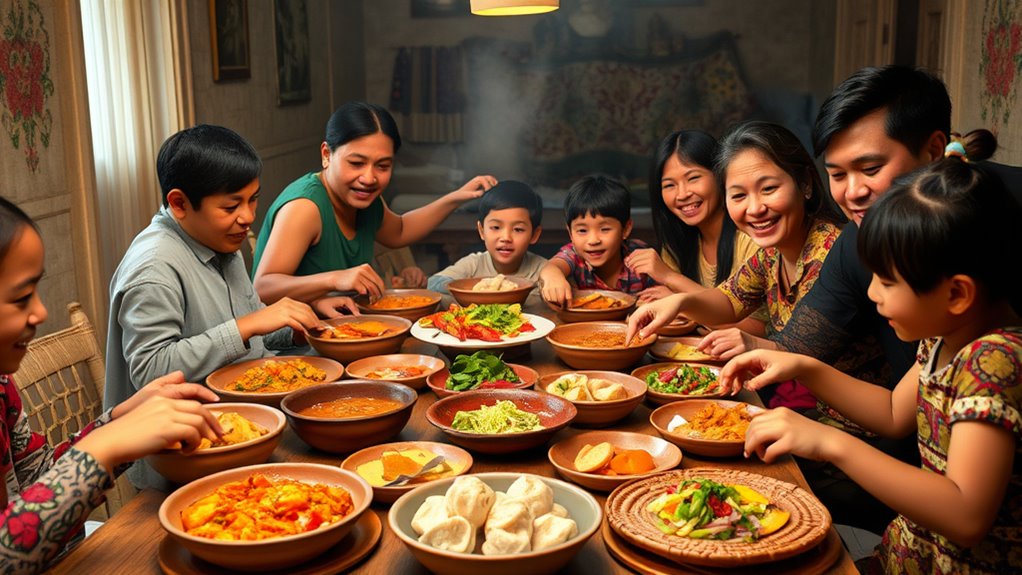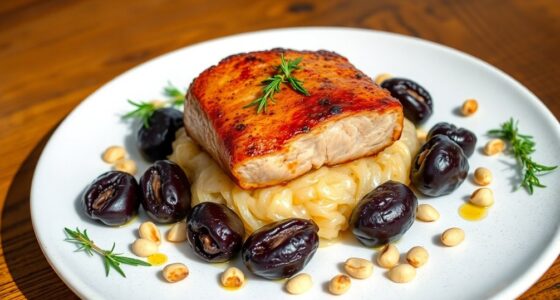Dinner traditions across cultures reflect shared values, history, and social bonds that bring families together. You might find communal dishes, specific manners, or rituals like giving thanks shaping these meals. Some cultures focus on formal gatherings with special courses, while others emphasize relaxed, conversational get-togethers. These customs celebrate life, foster belonging, and honor ancestors. Exploring these traditions further reveals the rich diversity of how families connect around food worldwide. If you continue, you’ll uncover fascinating stories behind each cultural practice.
Key Takeaways
- Family meals often involve specific foods, rituals, and manners that reflect cultural values and traditions.
- Communal sharing of dishes symbolizes unity, cooperation, and social bonds in many cultures.
- Formal and relaxed dinner settings serve different social purposes, from honoring traditions to fostering connection.
- Cultural celebrations and festivals emphasize shared meals, gratitude, and the reinforcement of cultural identity.
- Dinner routines vary globally, highlighting diverse practices such as passing food by hand or using chopsticks.

Dinner traditions are an important part of many cultures, shaping how families and communities come together at the end of the day. These customs go beyond just sharing a meal; they reflect values, history, and social bonds that define a culture’s identity. When you sit down for dinner, you participate in a ritual that often involves specific foods, customs, and manners passed down through generations.
You might find that in some cultures, dinner is a formal occasion, with everyone dressed up and seated around a carefully prepared table. In others, it’s a more relaxed affair, where the focus is on connection and conversation rather than presentation. No matter the style, these traditions serve a purpose: they foster a sense of belonging and reinforce relationships.
In many Asian cultures, dinner is a time to honor family and ancestors. You might notice that communal dishes are shared, with everyone gathering around a large platter or several bowls, passing food hand-to-hand. This practice emphasizes unity, cooperation, and respect for tradition. Chopsticks are often used, and you’re expected to show manners that demonstrate humility and gratitude for the meal.
In contrast, Mediterranean families might gather around a table filled with an array of vibrant dishes—olive oil, fresh vegetables, grilled meats, and bread. The emphasis here is on hospitality and abundance, with meals often lasting for hours as conversations flow freely. Sharing food is seen as a way to celebrate life and forge stronger bonds.
In many Western cultures, dinner routines often revolve around a set time and a more individualistic approach. People may eat separately during busy weekdays but come together on weekends or special occasions. The focus might be on a sit-down meal with specific courses, or casual gatherings with takeout and shared dishes.
Additionally, some cultures incorporate specific rituals such as festivals or ceremonies that highlight the significance of shared meals and reinforce cultural identity. Manners and conversation are key; you’re expected to listen, engage, and show appreciation for the effort put into preparing the meal. Many families incorporate traditions like grace before eating or giving thanks, which serve to acknowledge the effort and the food’s significance.
Across the globe, dinner traditions reflect the diversity of human experience. Whether it’s a formal banquet, a simple family meal, or a communal feast, these customs shape how you connect with others at the end of each day. They remind you that food isn’t just sustenance—it’s a way to honor your culture, strengthen relationships, and create lasting memories.
Embracing these traditions can deepen your understanding of different communities and enrich your own appreciation for shared meals.
Frequently Asked Questions
How Do Dietary Restrictions Influence Family Dinner Customs?
Dietary restrictions shape your family dinner customs by guiding what you prepare and how everyone participates. You might find yourself accommodating allergies, religious rules, or health choices, which influences menu planning and mealtime discussions.
These restrictions encourage creativity and communication, making each meal a reflection of your values. You adapt recipes and ingredients, ensuring everyone’s needs are met while maintaining a sense of togetherness during your shared family meals.
What Role Does Music Play During Family Meals Across Cultures?
Music enhances family meals by creating a warm, inviting atmosphere, helping everyone feel relaxed and connected. Across cultures, it often sets the mood, whether through traditional tunes or popular songs, encouraging conversation and shared enjoyment.
You might notice music playing softly in the background or being part of the meal itself, making the experience more meaningful. It’s a simple way to strengthen bonds and celebrate cultural identity during mealtime.
Are There Specific Etiquette Rules Unique to Different Countries?
You might think etiquette is universal, but it varies widely across countries. For example, in Japan, you bow and avoid sticking chopsticks upright in rice, while in France, politeness involves saying “Bon appétit” and keeping hands visible.
These rules reflect cultural values and social hierarchies. So, when dining abroad, you adapt to local customs—it’s a sign of respect and appreciation for their traditions.
How Do Modern Lifestyles Impact Traditional Dinner Practices?
Modern lifestyles markedly impact traditional dinner practices by making family meals less frequent and more hurried. You might find that work schedules, technology, and social commitments reduce the time spent together at mealtime.
Instead of leisurely family dinners, you often grab quick bites or eat alone. Despite these changes, many still value the importance of sharing meals, but adapt their routines to fit their busy, modern lives.
What Are Common Symbolic Foods Served During Family Dinners Worldwide?
You might notice that symbolic foods play a big role during family dinners worldwide. For example, in China, eating fish symbolizes abundance; in Italy, lentils represent prosperity; and in the US, turkey is linked to gratitude.
These foods often carry cultural or spiritual meanings, helping you connect with traditions and values. By sharing these dishes, you celebrate heritage and strengthen bonds with loved ones during special occasions.
Conclusion
So, next time you sit down for dinner, remember you’re part of a global symphony of traditions that span centuries and continents. Your family meal isn’t just about food; it’s a powerful, universe-shaking ritual that connects you to countless others across the world. Embrace these moments, because in the grand tapestry of cultures, your dinner table is the heartbeat—pulsing with history, love, and the incredible magic of shared nourishment.









